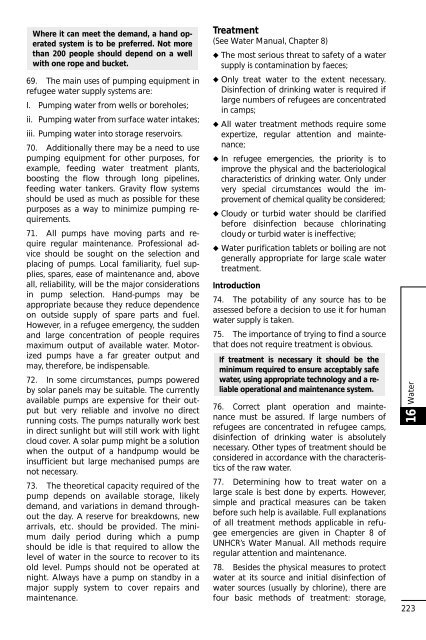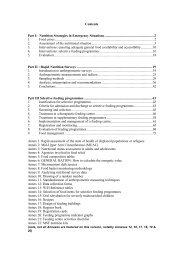UNHCR Handbook for Emergencies - UNHCR eCentre
UNHCR Handbook for Emergencies - UNHCR eCentre
UNHCR Handbook for Emergencies - UNHCR eCentre
Create successful ePaper yourself
Turn your PDF publications into a flip-book with our unique Google optimized e-Paper software.
Where it can meet the demand, a hand operated<br />
system is to be preferred. Not more<br />
than 200 people should depend on a well<br />
with one rope and bucket.<br />
69. The main uses of pumping equipment in<br />
refugee water supply systems are:<br />
I. Pumping water from wells or boreholes;<br />
ii. Pumping water from surface water intakes;<br />
iii. Pumping water into storage reservoirs.<br />
70. Additionally there may be a need to use<br />
pumping equipment <strong>for</strong> other purposes, <strong>for</strong><br />
example, feeding water treatment plants,<br />
boosting the flow through long pipelines,<br />
feeding water tankers. Gravity flow systems<br />
should be used as much as possible <strong>for</strong> these<br />
purposes as a way to minimize pumping requirements.<br />
71. All pumps have moving parts and require<br />
regular maintenance. Professional advice<br />
should be sought on the selection and<br />
placing of pumps. Local familiarity, fuel supplies,<br />
spares, ease of maintenance and, above<br />
all, reliability, will be the major considerations<br />
in pump selection. Hand-pumps may be<br />
appropriate because they reduce dependence<br />
on outside supply of spare parts and fuel.<br />
However, in a refugee emergency, the sudden<br />
and large concentration of people requires<br />
maximum output of available water. Motorized<br />
pumps have a far greater output and<br />
may, there<strong>for</strong>e, be indispensable.<br />
72. In some circumstances, pumps powered<br />
by solar panels may be suitable. The currently<br />
available pumps are expensive <strong>for</strong> their output<br />
but very reliable and involve no direct<br />
running costs. The pumps naturally work best<br />
in direct sunlight but will still work with light<br />
cloud cover. A solar pump might be a solution<br />
when the output of a handpump would be<br />
insufficient but large mechanised pumps are<br />
not necessary.<br />
73. The theoretical capacity required of the<br />
pump depends on available storage, likely<br />
demand, and variations in demand throughout<br />
the day. A reserve <strong>for</strong> breakdowns, new<br />
arrivals, etc. should be provided. The minimum<br />
daily period during which a pump<br />
should be idle is that required to allow the<br />
level of water in the source to recover to its<br />
old level. Pumps should not be operated at<br />
night. Always have a pump on standby in a<br />
major supply system to cover repairs and<br />
maintenance.<br />
Treatment<br />
(See Water Manual, Chapter 8)<br />
◆ The most serious threat to safety of a water<br />
supply is contamination by faeces;<br />
◆ Only treat water to the extent necessary.<br />
Disinfection of drinking water is required if<br />
large numbers of refugees are concentrated<br />
in camps;<br />
◆ All water treatment methods require some<br />
expertize, regular attention and maintenance;<br />
◆ In refugee emergencies, the priority is to<br />
improve the physical and the bacteriological<br />
characteristics of drinking water. Only under<br />
very special circumstances would the improvement<br />
of chemical quality be considered;<br />
◆ Cloudy or turbid water should be clarified<br />
be<strong>for</strong>e disinfection because chlorinating<br />
cloudy or turbid water is ineffective;<br />
◆ Water purification tablets or boiling are not<br />
generally appropriate <strong>for</strong> large scale water<br />
treatment.<br />
Introduction<br />
74. The potability of any source has to be<br />
assessed be<strong>for</strong>e a decision to use it <strong>for</strong> human<br />
water supply is taken.<br />
75. The importance of trying to find a source<br />
that does not require treatment is obvious.<br />
If treatment is necessary it should be the<br />
minimum required to ensure acceptably safe<br />
water, using appropriate technology and a reliable<br />
operational and maintenance system.<br />
76. Correct plant operation and maintenance<br />
must be assured. If large numbers of<br />
refugees are concentrated in refugee camps,<br />
disinfection of drinking water is absolutely<br />
necessary. Other types of treatment should be<br />
considered in accordance with the characteristics<br />
of the raw water.<br />
77. Determining how to treat water on a<br />
large scale is best done by experts. However,<br />
simple and practical measures can be taken<br />
be<strong>for</strong>e such help is available. Full explanations<br />
of all treatment methods applicable in refugee<br />
emergencies are given in Chapter 8 of<br />
<strong>UNHCR</strong>’s Water Manual. All methods require<br />
regular attention and maintenance.<br />
78. Besides the physical measures to protect<br />
water at its source and initial disinfection of<br />
water sources (usually by chlorine), there are<br />
four basic methods of treatment: storage,<br />
Water<br />
16<br />
223



